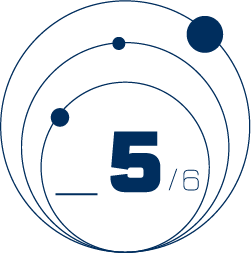AEROSPACE ENGINEERING
STRATEGIC VISION
//////// 2022-2027
Exploration Is a Fundamental
Human Pursuit
We yearn to reach the stars and sky and have developed the means to get there. Since the first sustained heavier-than-air powered flight by the Wright Brothers at Kitty Hawk on the 17th of December 1903, the aerospace profession has been creating vehicles that go faster, higher, farther, and fly for longer. In the past century, we have developed vehicles that have connected the globe to democratize and expedite human travel, sustain commerce, and connect societies. We have also sent humans and robots beyond our atmosphere to help uncover fundamental concepts about how we got here. Perhaps more than any other engineering field, we embody the aspirational human qualities of curiosity and exploration.
The next century brings new and difficult challenges and requirements to the technological developments at the center of our profession. Climate change poses an existential threat, and we must reduce and eliminate the emissions that our vehicles produce.
Similarly, our cities are becoming congested, sprawling, and over-crowded; new local air transportation mechanisms are needed to support more efficient transport of people and goods within our urban centers. We must leverage the rapidly emerging information revolution to enable faster and more efficient end-to-end design of new systems to avoid the inefficiencies of developing advanced systems that cost too much and take too long to get into service. We must also embrace that space is on the verge of becoming more readily accessible to humans and machines, and determine how we can develop more sustainable and lasting space systems that benefit everyone. Moreover, as an academic institution, we must prepare our students to understand and address all these challenges.
A long and notable history of addressing critical aerospace needs
Being the oldest aeronautical program in the USA formed just 11 years after Kitty Hawk, we have produced foundational research in multiple aerospace areas: aerodynamics, structures, propulsion, controls and multi-disciplinary system and vehicle design. More recently, the department has been establishing itself as a leader in emerging areas like small satellite design, advanced space-propulsion, autonomy, and human-robot interaction. We regularly collaborate with industry and government agencies for funding opportunities and launch vehicles, and many student teams have launched projects into orbit. We are also hosting several national and international centers of both government and industrial relevance. Finally, our alumni represent many of the top academic, industry, and governmental leaders who impact every aspect of the aerospace enterprise and beyond.
Building on our strengths and successes, our additional strategic directions will ensure that our disciplines, department, and profession are addressing critical societal needs, and laying the groundwork for the development of next-generation systems. Our leadership in these areas will also ensure the recruitment of the best students, faculty, and staff. We aim to continue to promote a culture of innovation in education and research to enable the creation of ideas, knowledge, and practices that will shape the future landscape of aerospace engineering for the common good. Our goal is to lead the aerospace enterprise by engaging in cutting-edge research and in educating students with the skills and thought processes to lead in their post-graduate careers.
Building the next age of Flight
It is vital that we continually adapt and reinvent ourselves to ensure that human exploration of this world and beyond becomes accessible to the many and that the boundaries of human existence continue to expand. Looking forward, we must build on this legacy of leadership to enable the next age of flight. After significant engagement with internal and external stakeholders and experts in the field, we have identified six thrusts that will inform our future activities.
As we set forth our vision, we are grounded in our values, in the landscape of aerospace engineering, and in need for aerospace leaders who embody the holistic and diverse lens that shapes societal needs for the public good.
We continue to pursue innovative, equitable, interdisciplinary, leading-edge research and teaching to develop the future of aerospace engineering.
These are our strategic thrusts.

SUSTAINABLE AIR TRANSPORTATION:
Ensure that fundamental research and development target a reality in which the vehicles we create are sustainably interacting with the world we are exploring.

COMMERCIAL SPACE:
Develop new, efficient, and sustainable ways for launching, manufacturing, controlling, and communicating with next generation human and robotic space missions.

DIGITAL ENGINEERING:
Harness emerging computational paradigms and information systems to significantly speed up the end-to-end development and certification of new aerospace systems.

RESILIENT AUTONOMOUS SYSTEMS:
Advance next generation autonomous systems that can work with humans to reduce human workload and enable entirely new classes of vehicle capabilities.

ADVANCED AIR MOBILITY:
Adapt to the changing needs of urban and regional transportation of people and goods.

AEROSPACE DEGREE FLEXIBILITY:
Ensure that we can provide our students with a rich, contemporary curriculum to prepare them for the future workforce.
